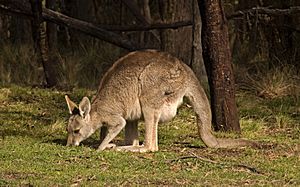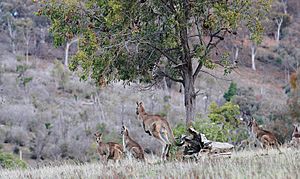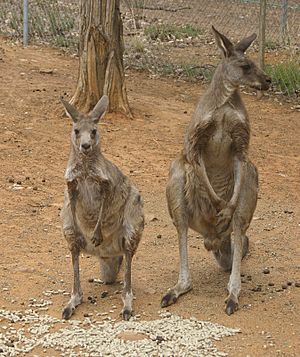Eastern grey kangaroo facts for kids
Quick facts for kids Eastern grey kangaroo |
|
|---|---|
 |
|
| Conservation status | |
| Scientific classification | |
| Kingdom: | |
| Class: | |
| Infraclass: | |
| Order: | |
| Family: | |
| Genus: | |
| Binomial name | |
| Macropus giganteus |
|
The eastern grey kangaroo (Macropus giganteus) is a type of marsupial that lives in south and east Australia, including Tasmania. People also call it the great grey kangaroo or the forester kangaroo. A male eastern grey kangaroo can weigh about 66 kg (145 lb.) and stand almost 2 m (6 ft.) tall. Its scientific name, Macropus giganteus, means "gigantic (huge) large-foot." This kangaroo is the second biggest marsupial on Earth. The red kangaroo is the largest.
Contents
What Does the Eastern Grey Kangaroo Look Like?
The eastern grey kangaroo is the second largest and heaviest living marsupial in Australia. It is also the second largest native land mammal. Adult males usually weigh between 50 and 66 kg (110 to 145 lb). Females are smaller, weighing about 17 to 40 kg (37 to 88 lb).
These kangaroos are easy to spot because of their soft grey fur. They often live in wetter, more fertile areas. Red kangaroos, even if they look grey-blue, have different faces. Red kangaroos have clear black and white marks near their noses and on the sides of their faces. Grey kangaroos do not have these marks, and their eyes look big and wide open.
It can be harder to tell the difference between eastern grey and western grey kangaroos. This is because they are very similar and live in some of the same areas. Both have noses covered with fine hair. The eastern grey is light grey or brownish-grey, with a lighter, sometimes almost white, belly. The western grey is a darker dusty brown. The fastest speed ever recorded for any kangaroo was 64 km/h (40 mph). This speed was set by a large female eastern grey kangaroo.
Where Do Eastern Grey Kangaroos Live?
Even though the red kangaroo is more famous, the eastern grey kangaroo is the one most Australians see. This is because it can live in many different places. Many Australians live near the south and east coasts. From these cities, it's usually a short drive to areas where kangaroos live.
The eastern grey kangaroo likes open grasslands with bushes nearby for shelter during the day. They mostly live in the wetter parts of Australia. They also live in coastal areas, woodlands, sub-tropical forests, mountain forests, and inland scrubs.
Like all kangaroos, they are mostly active at night or during twilight (early morning or late evening). During the middle of the day, kangaroos rest in the shade of woodlands. They eat there, but then come out into open grasslands in large groups to feed. The eastern grey kangaroo mainly eats a wide variety of grasses.
Eastern Grey Kangaroo Behavior
Eastern grey kangaroos live in groups. These groups are open, meaning new kangaroos can join. A group usually has 2-3 females and their young, plus a similar number of males. One male is usually the leader. The leader gets better access to food and shady spots. Kangaroos do not defend their territory. They usually only fight when females are ready to have babies.
Kangaroos are careful about predators. Females with young, kangaroos on the edge of a group, and those far from cover are the most watchful. When more kangaroos are in a group, it provides more protection against predators.
Reproduction and Life Cycle
Female kangaroos often form strong bonds with their female relatives. Females with living female relatives have a better chance of having babies. Most kangaroo births happen during the summer.
A female kangaroo is usually always pregnant, except on the day she gives birth. However, she can pause the growth of an embryo until her older joey (baby kangaroo) is ready to leave the pouch. This is called embryonic diapause. It happens during dry times or when there isn't enough food.
The mother's milk changes to fit what her joey needs. She can even make two different kinds of milk at the same time. One type is for a newborn, and another is for an older joey still in the pouch.
During dry periods, male kangaroos will not produce sperm. Females will only get pregnant if there has been enough rain to grow lots of green plants. Females raise their young without help from the males. Joeys depend on their mothers for about 550 days until they stop drinking milk. Females can have babies when they are between 17 and 28 months old. Males are ready to mate around 25 months.
Eastern Grey Kangaroo Population Status
Some people believe that kangaroo populations have grown a lot since Europeans came to Australia. This might be because there are now more grasslands (instead of forests), fewer dingos, and more man-made water holes. In 2010, there were an estimated 11.4 million eastern grey kangaroos across Australia. In some areas, there are so many eastern grey kangaroos that they eat too much grass. Because of this, some groups of kangaroos have been managed in parts of Australia.
Even with some hunting and population management, the eastern grey kangaroo is still common and widespread. It still lives in all the same areas it did when Europeans arrived in Australia in 1788. Sometimes, they cause problems for farms because they eat crops or special grasses grown for livestock.
Gallery
Images for kids
-
An eastern grey kangaroo skull exhibited at the Smithsonian National Museum of Natural History in the National Mall, Washington D.C.
-
The underside of the hind foot with a sharp claw photographed at Merimbula in New South Wales
-
A joey in a pouch photographed at the Jerusalem Biblical Zoo in Malha, Jerusalem
-
A carcass of an eastern grey kangaroo caused by roadkill in Victoria, Australia
See also
 In Spanish: Canguro gris oriental para niños
In Spanish: Canguro gris oriental para niños
















